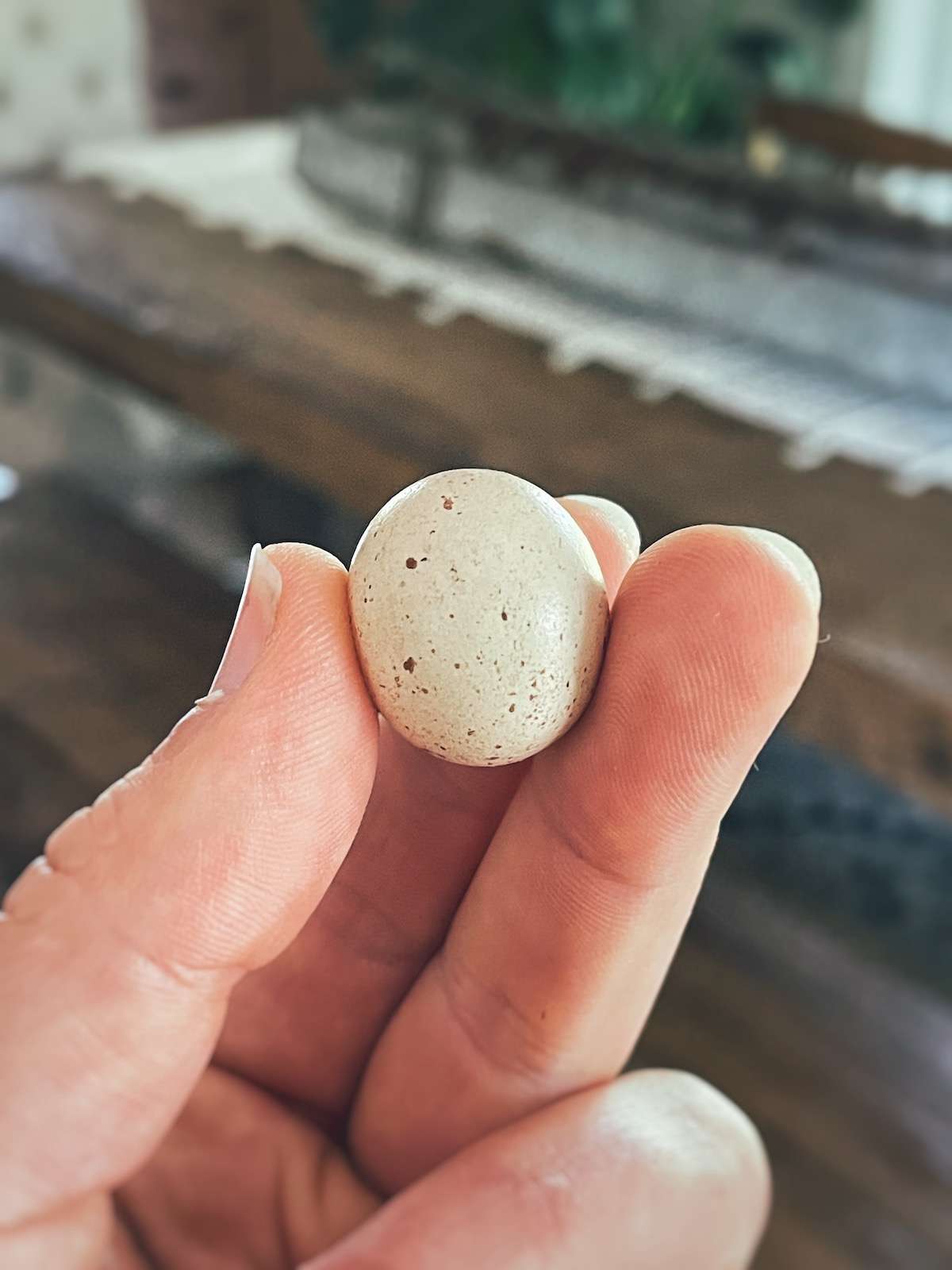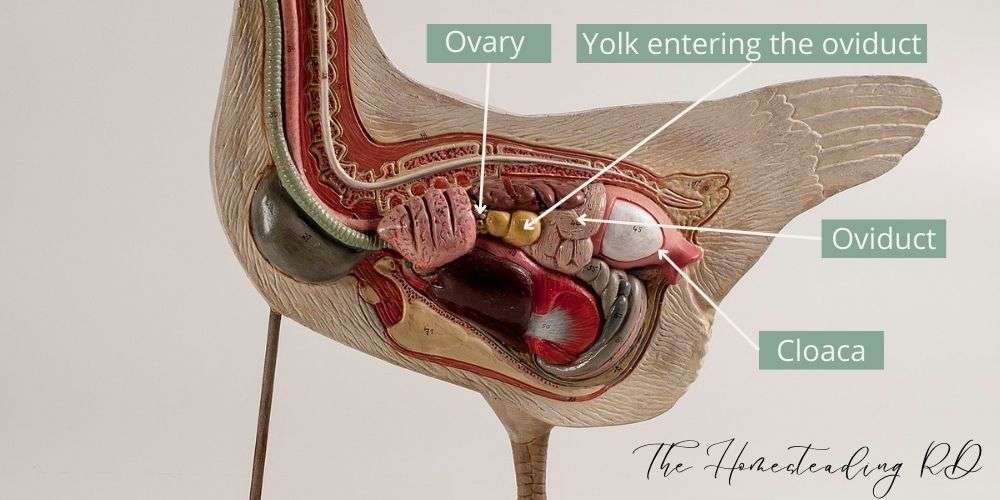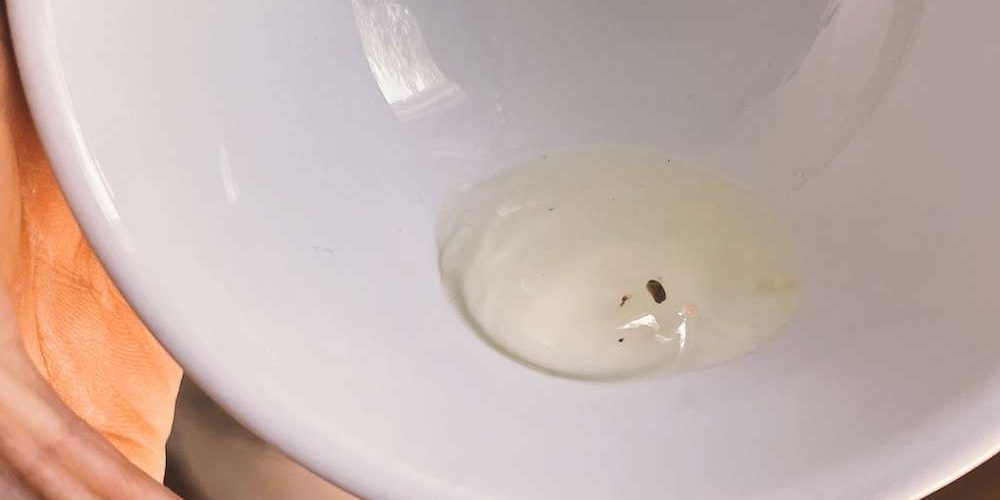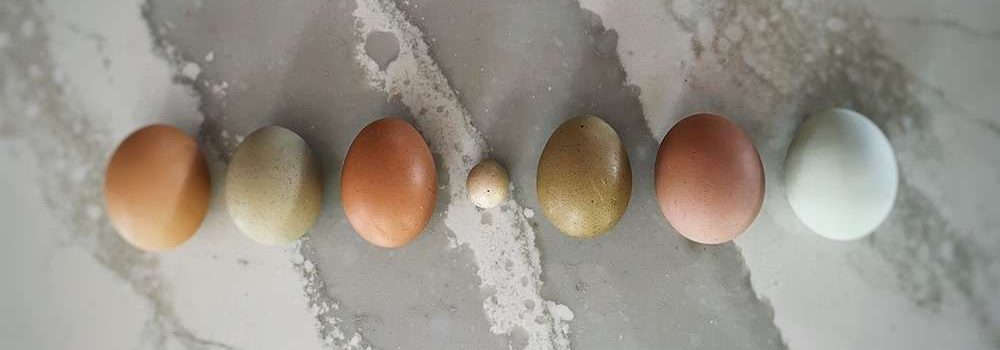Have you found a miniature egg in your hens’ laying box? Don’t panic! These are called fairy eggs and can happen for many different reasons. Most of the time, they are nothing to worry about and are just a fun surprise from time-to-time.
In this article we’ll discuss what fairy eggs are exactly, how they are made and answer all of your burning questions. Don’t miss the bonus section on my best tips for encouraging healthy laying in your flock.
Let’s jump in!
*Disclosure: This post may contain affiliate links to products (including Amazon). I’ll earn a small commission if you make a purchase through my link, at no additional cost to you! Regardless, I only link to products that I personally use on our homestead or believe in.
Fairy Eggs: What Are They?
Fairy eggs are simply tiny eggs that occur as a “misfire” in the hen’s reproductive system. It usually starts with a tiny piece of reproductive tissue breaking off and triggering the egg-producing glands to think it’s a yolk coming down the oviduct. Thus, a small amount of egg white is added, followed by the shell as it passes on through.
The hen’s reproductive system
I’m definitely a visual learner, so let’s start by taking a peek at a hen’s reproductive system to get a better idea of what’s going on.
The egg’s entire journey takes about 25 hours and travels roughly 25 inches before it’s plopped into the laying box. It all starts with the hen’s single ovary releasing a yolk about 1 hour after the previous egg was laid. Once the yolk enters the oviduct, the magic starts to begin!
First, the yolk is fertilized with a rooster’s sperm (if available), then surrounded by albumin (egg white) and further supported by shell membranes. About 5 hours have passed so far, but we’re not done yet! Next, the shell is added and pigmented and this takes a whopping 20 hours!
Lastly, the protective bloom coating is added to the outside of the shell before expelling it through the cloaca to exit through the vent. This bloom coating is essential for keeping the egg “fresh” for weeks to come. I never wash my eggs for this reason. The Chicken Chick does a fantastic job explaining the hen’s reproductive system more in detail with some great photos and videos if you want to learn more!
What’s inside a fairy egg?
Typically, there is no yolk inside fairy eggs. Most of the time you’ll find that a small piece of tissue that triggered the creation of the fairy egg in the first place, or just some basic egg white. You might occasionally find a little smear of yolk as well. It’s always a fun surprise to see what you’ll find in there! Below is a photo of what was inside my most recent fairy egg. Just a small piece of tissue.
Can you eat fairy eggs?
Absolutely! There is nothing toxic or inedible about fairy eggs. I personally like to remove any reproductive tissue, if present. However, the tissue is completely edible if you chose to consume it all.
If you are weirded out by the concept altogether, your dog will love it! Another option is to scramble it up and give it back to your chickens. They actually love scrambled eggs, as counterintuitive as that sounds.
Why Do Hens Lay Fairy Eggs?
There are several different reasons why hens can lay fairy eggs, but sometimes they just happen for no reason at all!
- She is a pullet (young hen) in her first month or two of laying so her reproductive system is still getting up to speed. This is completely normal!
- She is an older hen who’s reproductive system is worn down and not firing on all cylinders.
- The hen is stressed from overcrowding, a predator attack, too many roosters, high temperatures, etc.
- Insufficient nutrients in the diet, especially calcium or protein.
- Illness or pests (mites, lice, etc.). My favorite time to check for this is while my hens are roosting at night. They are much easier to catch and handle, plus some of the pests come out at night.
- Oopsies! Sometimes, fairy eggs just happen for no reason at all!
Should I Be Concerned About Fairy Eggs?
If you randomly find 1 fairy egg, I would just consider this a random “misfire” and revel at the treasure that you found! However, if this becomes a repeat issue, then I would do a thorough flock inspection for any signs of stress, disease, malnutrition, etc.
How to Encourage Healthy Laying
Chickens really are pretty simple creatures – they don’t need much! Here’s a few things to ensure in order to encourage healthy laying in your flock of hens:
Calcium
Calcium is the essential nutrient for creating strong eggshells. Layer feed should be offered to hens once they reach 18 weeks old, or start laying. Layer feed should contain adequate amounts of calcium to support egg laying, however, I always provide supplemental calcium as well.
Oyster shell is the most common form of calcium and can be set out in a separate dish for your hens to pick and choose as she desires. If your entire flock is on starter or grower feed during the summer months while integrating new chicks, then you absolutely should be offering supplemental oyster shell.
The Homesteading RD's Product Picks: | |
If you have a smaller flock (5-10 hens), then this is a great size to buy! I used to buy this one when I was first starting out with a small flock. | |
If you have a larger flock (15+ hens), I'd recommend this one! This is the one that I buy and my hens love it. I've tried other bulk brands, but this is by far the best and favorite of my hens. | |
Protein
Adequate protein is also important not only for the hens’ overall health, but for producing eggs. Most commercial laying rations should provide adequate protein, but if you are mixing your own feed make sure to provide 16-18% protein. If your hens free range, know that they’ll likely get an extra boost of protein from the bugs, worms, frogs and mice (yes, mice!) that they find along their day.
Stress
This is huge! We all know what stress feels like, and it doesn’t feel good. Funky things start happening when we’re stressed, and then same goes for chickens. Stress can come from too many roosters, predator attacks, too few laying boxes, periods with no food/water, extreme temperatures, pests (mites, lice, etc.) or illness. If you start to notice a reduction in laying or funky looking eggs, search around for potential stress triggers.
Want to see me chatting about fairy eggs? Check out my reel on Instagram!
Up your chicken-keeping game
Below are my favorite 2 chicken books that I keep coming back to time after time. Everything you’ll ever need to know are in these two books!
The Homesteading RD's Product Picks: | |
This is THE chicken book to have! I've had my copy since the beginning and it's the one that I keep going back to time after time. It provides everything you need to know from coop design, hatching chicks, layer nutrition, and much more! There is some health information, but I'd recommend the book below for comprehensive health information | |
After a few health scares in my flock, I quickly purchased this book and it has been a lifesaver! Anything that could potentially come up in your flock is addressed in this book with practical solutions. Worth every penny! | |
Other Names for Fairy Eggs
Fairy eggs have been called many different things throughout the ages. Here’s the most common ones you’ll hear people say. Personally, my favorite is fairy egg. It just adds to the cute and mysterious factor of these adorable miniature eggs!
- Cock egg
- Fairy egg
- Fart egg
- Rooster egg
- Wind egg
- Witch egg
Superstitions and Folklore
I love history, so let’s nerd out together for a few minutes! Back in the middle ages, it was believed that these tiny eggs were laid by roosters and thus, called “cock eggs.” In fact, a rooster even went on trial in 1474 for “the heinous and unnatural crime of laying an egg” and was sentenced to burning alive on the stake. Not kidding! These types of trials and accusations continued well into the 1700’s.
Why so much fear around cock eggs? It was “well-known” that mythical beasts such as the cockatrice or basilisk would emerge from these eggs if hatched! To prevent this from happening, an individual was instructed to toss the cock egg over their house (without touching the roof) so that it smashed on the other side. Then, everyone would be safe from mass destruction.
Other Articles You’ll Love
- Ultimate Guide to Chicken Nesting Box Size
- The 8 Best Egg Incubators
- Brooding in Poultry – Everything You Need to Know!
Conclusion
Well, this was a fun one! I hope you enjoyed learning about all things related to hen’s reproductive systems, why fairy eggs happen and even a little dragon tale. The next time you find a fairy egg, do a quick flock check to make sure everyone is healthy, but don’t forget to enjoy how cute they are!
*Information in this article was referenced from personal experience and/or from my favorite chicken books Storey’s Guide to Raising Chickens and The Chicken Health Handbook, unless otherwise noted.












I have 5 different hens in our school garden, and we found a fairy egg today. However, my students are calling it a solar eclipse egg, and are convinced this miniature egg is a result of the total solar eclipse we experienced today!
Haha could be! That’s so fun that you have hens at the school garden! I wish more schools did that.
Thanks for the interesting article. I found a couple of fairy eggs years ago who when I first got chickens. Less than a week ago someone had to give up their five chickens and I’m having to acclimate them to their new home. So far, I’ve gotten two fairy eggs. I thought it must be stress and your article confirmed it. It was a 2 hour drive over here and then a night huddled in their travel enclosure before they could run around in my fenced garden. We hope to finish their little pen today since it’s too soon to put them with the other flock. My husband jokes that our eggs only cost $38 a dozen and I give half of them away. I can say it’s been a learning adventure but I love my chickens, trouble or not. 🐓🐓🐓
Ooo yes sounds like stress-induced indeed! Sounds like you are doing a great job getting them acclimated. They are so fun to have around – enjoy your new chickens! 🙂
I want to to thank you for this good read!! I certainly loved every little bit of it. I have you bookmarked to look at new things you postÖ
You’re welcome and I’m so glad that you found it helpful. Glad to have you here 🙂
Omgoodness it is so cute. I never this can happen. So neat! Thanks for sharing.
They are so adorable and always a fun surprise when I find them!
I was wondering why some of our girls would give us these tiny butt nuggets. Thank you for the information!
You’re so welcome! 🙂
These are so cute! I think our chickens made one once, but it’s been a long time. The superstitions around fairy eggs are so interesting!
It’s it so fascinating? I thought so, too!
The whole process for how the egg is created is simply fascinating!
Isn’t it!? I think so, too!
I love that we call them fairy eggs! There’s something so adorable about that. Chickens are always a learning experience, but they’re wonderful critters.
I do, too! So much fun 🙂
When I saw your fairy egg video on Instagram, it sparked great interest. Never heard of fairy eggs;
They are about the size of quail eggs. When I was in Jamaica, I raised a lot of common chickens and never experience this reproductive defect in my chickens. I am surprised the fairy eggs do not have any yoke. Thanks for sharing the picture.
You must have had some healthy, happy chickens! They are quite rare. I only find 1-2 every year in my flock of 40. It’s always a fun surprise!
I was so excited with my first fairy egg that my girls laid!
They are a fun surprise!
How interesting! I’ve never heard of or seen a fairy egg! Thanks for the information! When we DO get chickens, this won’t scare me….as much. lol
They are pretty rare, but they do happen!
What an adorable miniature egg🥚. I could see myself eating 10 of them as tiny as I am lol
They are quite adorable 🙂